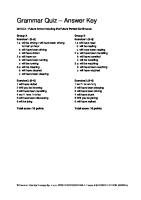STEM Quiz Answers: Culham Centre For Fusion Energy [PDF]
STEM quiz answers 1. What does STEM stand for? Science, Technology, Engineering and Maths. 2. True or False: This is a r
27 0 314KB
Papiere empfehlen
![STEM Quiz Answers: Culham Centre For Fusion Energy [PDF]](https://vdoc.tips/img/200x200/stem-quiz-answers-culham-centre-for-fusion-energy.jpg)
- Author / Uploaded
- Chincel G. ANI
Datei wird geladen, bitte warten...
Zitiervorschau
STEM quiz answers 1. What does STEM stand for? Science, Technology, Engineering and Maths. 2. True or False: This is a real STEM job: Legoland Designer Sports statistician Spotify engineer Professional hacker All true 3. How many people work in STEM in the UK? 5.8 million people, 20% of the workforce. 72% of UK businesses rely on people with STEM skills. 4. Where is Europe’s research centre for nuclear fusion? Switzerland France Germany UK (Oxfordshire) Culham Centre for Fusion Energy 5. If I do a science degree or A levels, do I have to be a scientist? No lots of industries want STEM graduates and you can convert your degree to go into Law for example or technical sales. 6. Do I need a university degree to work in STEM? No – you can go through an apprenticeship scheme. 7. How much more do STEM graduates earn in their lifetime in comparison to non-graduates? £50,000 £100,000 150,000 £250,000 Graduates tend to earn £160,000 more than non-graduates; whereas STEM graduates earn a whopping £250,000 more in their lifetime. Chemistry and Physics graduates will earn on average over 30% more during their working lifetimes than other A level holders. New study: http://www.telegraph.co.uk/finance/jobs/11008228/The-value-of-a-degree-500000-overyour-career.html 8. True or False: STEM careers aren’t for creative people False! Examples: http://www.rainbowwinters.com/home2.html - they have developed clothing that reacts to different stimuli such as water or light. Using electronics in textiles, previously worn by Katy Perry. http://cutecircuit.com/ Research and development at Cadbury’s to make a new chocolate!
Designing an interesting building/stadium/etc (engineering) – one example is the London Olympics stadium which made use of wasteland Developing a brand new type of camera for surgery, based on a snake http://www.theguardian.com/science/2007/dec/29/medicalresearch Making energy from waste Special effects for films The Angel of the North Figuring out how old a painting is with chemistry A robot bear that cares for the elderly http://news.bbc.co.uk/1/hi/sci/tech/1829021.stm 9. How many types of STEM professionals are involved in making sure your water is clean? Nine From Future Morph website:
A water treatment worker – adds chemicals and microbes to water and monitors it to make sure it’s safe for people to drink
A civil engineer/water engineer – managing water supply and drainage networks and installing flood barriers
A geoscientist –searching for new water supplies and assessing safety and impact of work done by Civil Engineers
A geotechnician – obtaining and analyzing samples and interpreting data to support the work of geoscientists
A chemist – developing ways to keep water supplies clean
A meteorologist – measuring and predicting the weather so people are prepared for floods or droughts
A water quality scientist – maintaining the quality of water by testing and comparing samples
An environmental consultant – identifying any sources of contamination which affect water supplies
A waste management officer – managing waste so that it does not contaminate water supplies









